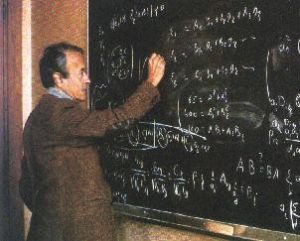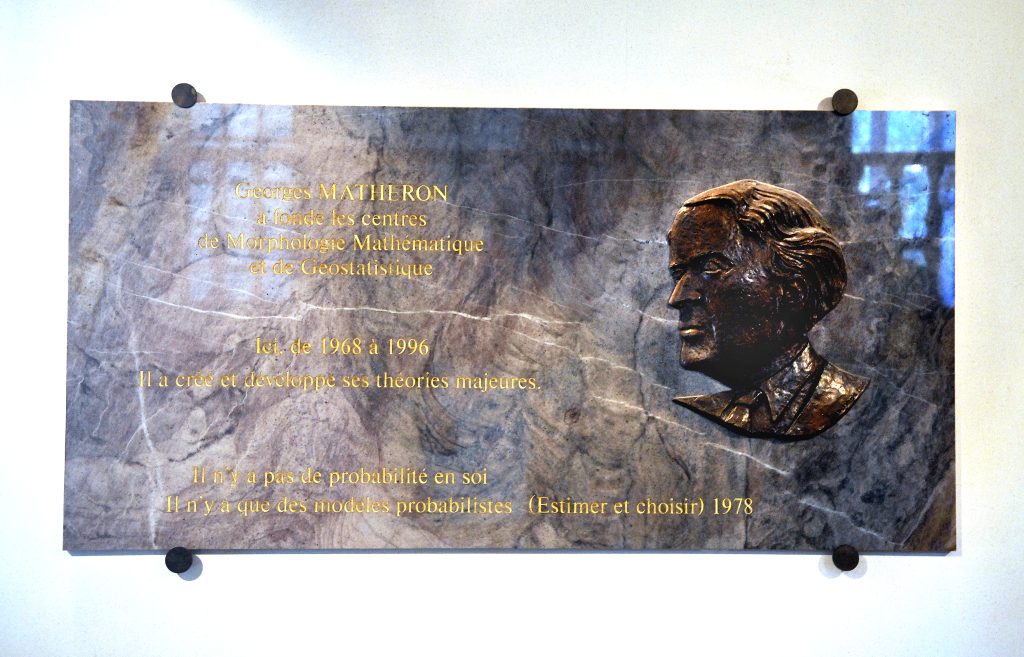Georges Matheron (English)
Professor Georges Matheron (1930 – 2000)
- A life devoted to probabilistic modeling
- Professor Georges Matheron, is the founder of Geostatistics. He was at the École Polytechnique (X49), then at the École des Mines de Paris (engineer from the Corps des Mines), where he perfected his skills in mathematics, physics and probability. Paul Lévy has been one of his professors, one of the giants of probability whose influence is present throughout his work. From 1954 to 1963, during a stay at the Bureau of Geological and Mining Research in Algeria and France, he discovers the pioneering work of the South African school (Krige, Sichel, de Wijs) devoted to the gold mines of the Witwatersrand and develops the major concepts of geostatistics, a theory for the estimation of natural resources. These first works find their culmination by the publication of two main documents (Memoires of the BRGM):
- The monumental Treaty of applied geostatistics (Editions Technip, France, 1962-63), where the fundamental tools of linear geostatistics are defined: variography, estimation and dispersion variances, kriging, called after the contributions of the South African engineer Danie Krige (we can consult the article of the Encyclopedia Universalis devoted to this theory),
- A more theoretical book, his thesis, entitled Regionalized variables and their estimation: an application of the theory of random functions to the natural sciences , published by Masson in 1965.

From 1964 to 1968, G. Matheron pays attention to the mathematical characterization of objects and creates a new discipline, in collaboration with Jean Serra, Mathematical Morphology , which has become one of the essential components of the image processing. At the same time, he also worked on hydrodynamics and in 1967 published the Elements for a theory of porous media (Masson).
After developing a course on probability and geostatistics at the École des Mines de Nancy, G. Matheron joins the École des Mines de Paris and in 1968, takes the head of a newly created research center, the Center of Mathematical Morphology (CMM) in Fontainebleau. Due to the diversity of its applications, it becomes the Center of Geostatistics and Mathematical Morphology (CGMM) in 1979, then is eventually split in 1986, with J. Serra director of the new Center of Mathematical Morphology , and G. Matheron director of the Center for Geostatistics (CG). The famous Fascicle 5 of the Notebooks of the Center of Mathematical Morphology of Fontainebleau, entitled Theory of regionalized variables, and its applications (Matheron, 1970) will be the geostatistical bible of number of students and researchers.
In Fontainebleau, G. Matheron demonstrates an overflowing creativity, developing with a team of collaborators (André Journel, Alain Maréchal, Pierre Delfiner, Jean-Paul Chilès, to quote few students) the concepts of nonlinear geostatistics and of non stationary geostatistics, while keeping a marked interest in other mining problems (such as the optimization of open pits) and in Mathematical Morphology. In 1975 he publishes Random sets and integral geometry (Wiley), an essential contribution to the theory of random sets.
G. Matheron, whose entire life has been devoted to research, has published more than 250 notes and five books. His work is full of ideas, concepts and models that will inspire engineers and researchers. A large part of these publications are available in the online library of the Geostatistics team.
Through this abundant and eclectic production, we find a recurring theme: the use of probabilistic models. G. Matheron has shown an exceptional capacity to tackle problems reputed to be insoluble, to reduce them to simpler questions which he solves by appropriate models. This is the reason why the methods and concepts he developed are still relevant today: they respond to real problems.
The best proof is the astonishing variety of applications of geostatistics: formerly devoted to mining applications, it is now used in petroleum, forests, agronomy, oceanography, meteorology, fisheries, environment, etc.
This sum of experiments in modeling unique natural phenomena through a probabilistic approach led G. Matheron to write Estimate and choose: an essay on applied probabilities in 1978, that anyone working with probabilities should read. As A.M. Hasofer notes in the preface of the English translation ( Estimating and choosing: an essay on probability in practice , Springer, 1989):
“Reading Matheron’s work is an enlightenment. We find there a coherent elaborate framework leading to the purely objective use of probabilistic models for the description of unique phenomena. By a unifying vision, Matheron was able to eliminate from the practice of probability the philosophical gangue which had made it obscure and confused for decades. He offers us a guideline to determine the adequacy and the limits of probabilistic modeling”.
Beyond his exceptional scientific capacities, G. Matheron was a master in the literal sense: how many students or professionals have seen their career initiated or modified by his teaching, his publications, or by exchanging with him?
The death of Georges Matheron in 2000 marked the end of an era: in addition to his numerous writings, he left behind him two rapidly expanding disciplines, Geostatistics and Mathematical Morphology.

